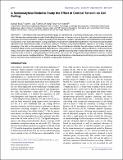A Semianalytical Model to Study the Effect of Cortical Tension on Cell Rolling
Author(s)
Bose, Suman; Das, Sarit K.; Karp, Jeffrey Michael; Karnik, Rohit
DownloadBose-2010-A Semianalytical Mod.pdf (621.8Kb)
PUBLISHER_POLICY
Publisher Policy
Article is made available in accordance with the publisher's policy and may be subject to US copyright law. Please refer to the publisher's site for terms of use.
Terms of use
Metadata
Show full item recordAbstract
Cell rolling on the vascular endothelium plays an important role in trafficking of leukocytes, stem cells, and cancer cells. We describe a semianalytical model of cell rolling that focuses on the microvillus as the unit of cell-substrate interaction and integrates microvillus mechanics, receptor clustering, force-dependent receptor-ligand kinetics, and cortical tension that enables incorporation of cell body deformation. Using parameters obtained from independent experiments, the model showed excellent agreement with experimental studies of neutrophil rolling on P-selectin and predicted different regimes of cell rolling, including spreading of the cells on the substrate under high shear. The cortical tension affected the cell-surface contact area and influenced the rolling velocity, and modulated the dependence of rolling velocity on microvillus stiffness. Moreover, at the same shear stress, microvilli of cells with higher cortical tension carried a greater load compared to those with lower cortical tension. We also used the model to obtain a scaling dependence of the contact radius and cell rolling velocity under different conditions of shear stress, cortical tension, and ligand density. This model advances theoretical understanding of cell rolling by incorporating cortical tension and microvillus extension into a versatile, semianalytical framework.
Date issued
2010-12Department
Harvard University--MIT Division of Health Sciences and Technology; Massachusetts Institute of Technology. Department of Mechanical Engineering; Koch Institute for Integrative Cancer Research at MITJournal
Biophysical Journal
Publisher
Elsevier B.V.
Citation
Bose, Suman, Sarit K. Das, Jeffrey M. Karp, and Rohit Karnik. “A Semianalytical Model to Study the Effect of Cortical Tension on Cell Rolling.” Biophysical Journal 99, no. 12 (December 2010): 3870–3879. © 2010 Elsevier B.V.
Version: Final published version
ISSN
00063495